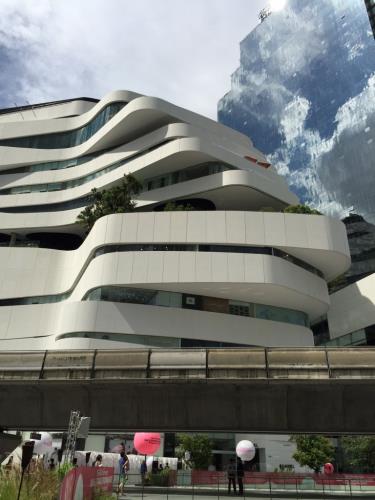Yap loves design, travel and everything beautiful in life. He writes for various media about travel and design and has published works, including Wander Bhutan and Myanmar Odyssey. Formerly publisher of Lonely Planet (China Office), Yap is now Chief Content Officer of Youpu Apps, a Beijing based travel app company.

I thought I arrived at a jam factory when I saw the company name. In fact, it reflects the vision of the designer of this place: like a jazz improvisation by a jam band, the space is a catalyser of innovative ideas. Environment can shape human behaviour. When a person is living in a neatly regulated space, his or her mind would be imprisoned by comfort and efficiency. If one is living in a maze, perhaps he or she would have incentives to discover and explore.
The Jam Factory is not conveniently located, but going there is part of the fun. You can reach there by hopping on a boat that leaves from the pier adjacent to the Sheraton by Chao Phraya River. The Jam Factory is housed in a disused factory and warehouse that used to manufacture batteries. Duangrit Bunnag, a prominent designer in Thailand, discovered this stretch of wasteland when he was searching for a new office location. He has kept the original structure of the factory, the banyan trees and their tangled roots in the courtyard, and traces of the factory’s history. When Bunnag was renovating the place, he got an outpouring of ideas. Eventually they were turned into reality. Restaurants, cafés, bookshops and lifestyle shops now have occupied the space. A privately-run creative enterprise usually boasts more personality and character because of the charisma and talent of its founder. It, however, has business pressure, too. To deal with it, The Jam Factory held a series of creative and cultural events and bazaars not long after its opening, with the aim of attracting more visitors and establishing itself as a trendsetter in Bangkok.
If you want to know more about emerging designers in Thailand, the concept stores in The Jam Factory may give you some hints. Products designed by the new talent are showcased in the shops. They include furniture, home accessories and groceries. Thinkk Studio, Studio 248 and Labrador are definitely the young, emerging brands to keep an eye on. I have noticed that Bangkok’s homeware designers have gradually shifted from selling exoticism of traditions to a more global approach. A local designer told me that young designers are usually educated overseas and exposed to different cultures. When they come back to Thailand, they will make adjustment in the design according to local context. Local elements are downplayed, while modernity is emphasised. Lots of products are designed with a Japanese or Scandinavian touch. By doing this the products are easier to appeal to the global market. Living spaces are getting tighter and tighter in Bangkok. Furniture designs, therefore, have to be simplistic and pragmatic. Sizes of the furniture have to be reduced, too. The new designs have attracted people from Singapore, Malaysia, Hong Kong and Taiwan to buy furniture in Bangkok. Some furniture retailers in Asia have also started selling Thailand-made furniture.
Bangkok is a fast-growing city but it lacks urban planning. There’s no quality public space in Bangkok for people to stroll and most likely you end up spending most of the time walking in shopping malls. These highly commercialised spaces are seen as public spaces in Bangkok. There is no shortage of such gigantic malls in the city, and they all have distinct character and positioning. In recent years, shopping centres that put focus on design are mushrooming. They spare no effort in helping local designers by housing concept stores run by local talent. Opened in mid-2015, Emquartier has become a talking point in Bangkok. Designed by New York-based Lesser Architecture, Emquartier boasts whimsical curved walls, an open air garden and green zones, providing the much-needed green spaces to the city. It is reported that the green spaces in Emquartier are two times more than other shopping malls. Apart from high-end stores, the mall boasts local designer stores. For instances, Qurator has a designated area that features locally-designed fashion. My favourite is a store called Another Story. It’s located on the 4th floor and you will find more than 230 brands sourced from all over the world there. The shop also encompasses lots of emerging local brands. About 70 of them are locally designed products, including furniture, homeware, stationery and fashion. For travellers who love designer accessories, you’ll find plenty of good-value and handy stuff there, and witness the innovative power of Thailand.